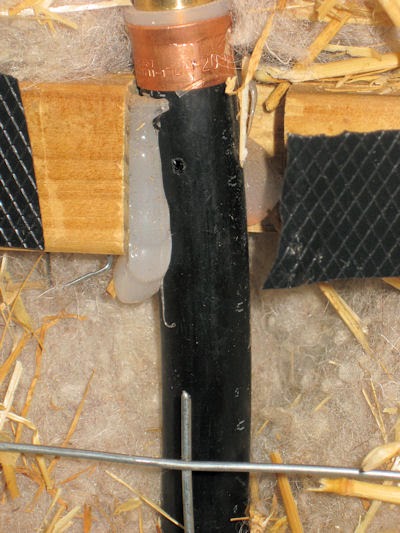So vertical strawbales into a double framed wall –
let’s chat about that for a moment.
If you know (or don’t) about strawbale houses, they
are usually divided into two types – load bearing and infill. They mean just what they say – you can build
a wall out of strawbales all by themselves and it will bear the load of the
roof, or you can use a frame, and the strawbales are infilled into that (and
mainly act as insulation as the load is borne on the frame). Obviously we have infill – but there are a
few different types of infill too – post and beam (where the frames are in only
the edges and top of the wall) – and then stud walls (lots of uprights and
horizontals, something like ours – and is very similar to how any other wood
framed house is built). From what I understand,
the choice in strawbale wall type is basically personal (they all work) and in
how ‘easy’ the different styles of strawbale buildings can be to get council
approval.
So vertical strawbales into a double framed wall –
why did we choose this method – so different to all the other styles of building?? Well, we kinda didn’t – it chose us, in a
way. This is the method Richard (our
building supervisor) uses, and we were happy to go along with it – we have
never been involved in any strawbale building before, so can’t have any
preference really.
I questioned Richard about why he has ‘evolved’ to
vertical baling and how the extra wood frame scores environmentally. These are my notes of his answer:
-
Vertical bales give a smaller footprint
on the slab, so less concrete is required (good for concrete, but what about a
possible decrease in insulation with decreased thickness?)
-
Vertical bales, face outwards, have the
direction of the straw stalks against the outside (wind side) – so theoretically
the insulation value could be higher (no studies have been done from what I
understand, but since the bales are so thick either way the R value is still
amazingly high. ETA – Richard tells me some studies
were done and the R value is actually higher with the stalks being across the
face J
-
Laying bales vertically uses less
strawbales in total as each bale covers a greater face (wall) area. You could use them on their side and still
get the greater face area, but the bales would tend to sag, so vertical is
stronger in that respect
-
Vertical bales can’t support themselves
so need supporting and the double frame does that. Tying to the external frame is also possible
(and Richard has moved away from this due to the last point below)
-
The pine used in framing is ‘stick’
timber, from young, quickly grown trees so not the massive environmental impact
of old growth trees (which are typically used in post and beam bale
construction for the extra strength required, albeit very often are recycled
wood)
-
But isn’t straw faster growing I asked,
so better for the environment anyway? Pretty
much even he reckons.
-
And, with modern homes, we usually like
to attach things to the walls (which don’t hold at all well in just straw), so
the extra internal framing provides plenty of fixing points for cupboards,
shelves, electric points etc J.
Now my big question – would we build again using
vertical strawbales??
Well, I don’t think I would do it exactly as we have
already done, put it that way. If there
is ever a next time (and there might be, for a smaller building somewhere
around), I think I would prefer to try a way that is much easier to actually get
the bales in. I would most certainly
size the walls to fit multiples of full bale sizes to lessen the number of
re-ties required!! I really like the
extra strength and positives of the double framing for a house but for a
smaller building I think easier bale raising would take preference as it just
seems more ‘user friendly’, and I think I would like that. I think I would like to actually be able to
be more hands-on in the bale raising (probably because I imagine I would be
more hands-on in the whole building process, maybe even having a go at wall framing
too??). It would be good to be involved
in that type of construction and compare…cubby house one day maybe eh?
(ETA – I typed this post up a couple of days ago and
as I went to sleep the thought popped into my head – one of the reasons I feel
some apprehension to vertical baling is that the physicality of it seems
somewhat aggressive and I don’t want that for our home. There has been plenty of physicality already,
but it has seemed persuasive compared to somewhat aggressive so didn’t seem ‘wrong’
– but really, how weird I feel to be anthropomorphising about this house! But that is me… and to be fair, we could have
spent a lot more time trimming the bales to ‘size’ so they fitted in easier and
therefore eliminated much of the physicality required too).





















